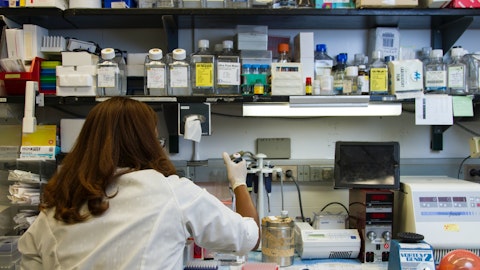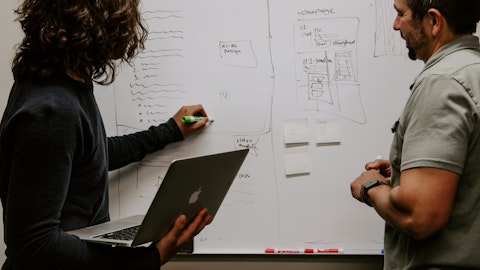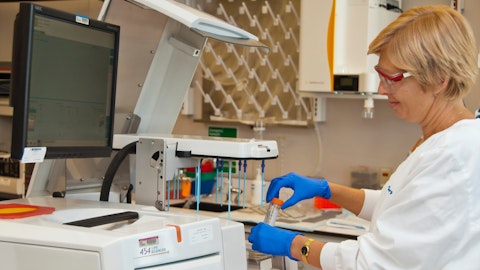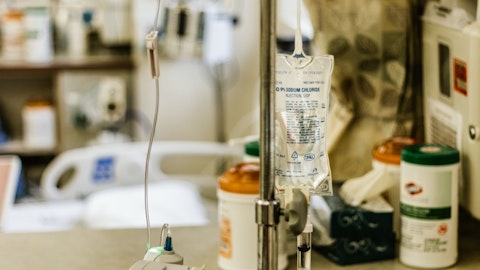Royalty Pharma plc (NASDAQ:RPRX) Q3 2023 Earnings Call Transcript November 8, 2023
Operator: Ladies and gentlemen, thank you for standing by. Welcome to the Royalty Pharma Third Quarter 2023 Earnings Conference Call. I would like now to turn the conference over to George Grofik, Senior Vice President, Head of Investor Relations and Communications. Please go ahead.
George Grofik: Good morning, and good afternoon to everyone on the call. Thank you for joining us to review Royalty Pharma’s Third Quarter 2023 results. You can find the press release with our earnings results and slides of this call on the Investors page of our website at royaltypharma.com. Moving to Slide 3. I would like to remind you that information presented in this call contains forward-looking statements that involve known and unknown risks, uncertainties and other factors that may cause actual results to differ materially from these statements. I refer you to our 10-K on file with the SEC for a description of these risks. All forward-looking statements are based on information currently available to Royalty Pharma and we assume no obligation to update any such forward-looking statements.
Non-GAAP financial measures will be used to help you understand our financial performance. The GAAP to non-GAAP reconciliations are provided in the earnings press release available on our website. And with that, please advance to Slide 4. Our speakers on the call today are Pablo Legorreta, Founder and Chief Executive Officer; Chris Hite, EVP, Vice Chairman; Marshall Urist, EVP, Head of Research and Investments; and Terry Coyne, EVP, Chief Financial Officer. Pablo will discuss key highlights. Chris will then provide an update on the PTC partnership, after which Marshall will discuss other portfolio updates. Next, Terry will review the financials and following concluding remarks from Pablo, we will hold the Q&A session. And with that, I’d like to turn the call over to Pablo.
Pablo Legorreta: Thank you, George, and welcome to everyone on the call. I am delighted to report another successful quarter of execution against our strategy as a leading funder of Innovation and Life Sciences. Slide 6 summarizes our financial portfolio and portfolio achievements in the third quarter, which again underscore tremendous momentum in our business. First, we delivered strong financial performance. Adjusted Cash Receipts, our top line grew by 9%, adjusted EBITDA by 9% and Adjusted Cash Flow grew by 10%. All of these metrics are prior to the Biohaven related payments, which we received in the third quarter of 2022. Second, on capital allocation, we had a very active past few months acquiring royalties on attractive therapies with announced transactions of $2.2 billion.
I am particularly pleased with our recently expanded PTC partnership, where we acquired incremental royalties on Evrysdi, which is for the treatment of spinal muscular atrophy. This transaction enhances our long-term growth diversifies our portfolio and is expected to generate an attractive unlevered return in the double digits. As Chris will explain later, this transaction was a great example of our unique ability to create tailored win-win solutions. This was also our busiest quarter ever for synthetic Royalty acquisitions with exciting transactions on 2 approved therapies, Skytrofa and Adstiladrin. On a year-to-date basis, we have announced Royalty transaction of up to $3.8 billion including $2.1 billion in upfront payments. Lastly, we continue to believe our shares are fundamentally undervalued and we repurchased an additional $144 million of our shares in the third quarter, taking our total year-to-date repurchases to $305 million orders as of last night’s close.
Third, we’re raising our full year guidance for adjusted cash received to be between $2.95 billion and $3 billion. Our guidance reflects expected underlying growth from our portfolio of around 10% prior to the Biohaven related payments. Consistent with our standard practice, our guidance is based on our current portfolio and does not include the benefit of any future acquisitions. On Slide 7, you can see our financials in more detail. We delivered 9% growth in our top line prior to Biohaven related payments in the prior period and 7% growth if we include this payment. Unlike the last several quarters, the impact of foreign exchange had a negligible impact on our top line growth. Similar to our top line, we grew adjusted EBITDA by 9% in the quarter prior to the Biohaven related payments and 6% including this payments.
Lastly, Adjusted Cash Flow grew by 10% in the quarter prior to the Biohaven related payment and 8% including this payment, both this quarter and the prior period included development stage payments. Slide 8 shows our impressive track record of strong top line growth since our IPO in June of 2020. We delivered 9% growth prior to the Biohaven-related payment through the first 3 quarters of 2023 after a strong growth in 2021 and 2022. This speaks to our ability to execute successfully and consistently against our strategy in the growing market for biopharma, Royalty. Slide 9 shows why we’re well positioned in the evolving interest rate environment. We’re committed to maintaining an investment-grade credit rating and our existing capital structure benefits from a long-duration, low-cost debt profile.
That being said, when making investments in a higher rate environment, our marginal cost of borrowing will inevitably rise. However, what is critical to recognize and that is our Royalty return expectations also adjust to this higher rate environment. This allows us to continue to deliver attractive returns of our above our cost of capital. The other important aspect to consider is that our opportunity set has expanded dramatically, driven by the huge capital needs of the industry and the increased role of Royalty. This trend has been accelerated by the macro environment, which has increased the cost of other sources of financing for biopharma companies. So taken together, we’re confident that Royalty Pharma will continue to thrive and perform strongly in an evolving rate environment.
On Slide 10, we want to unpack why we remain so excited about our ability to create compounding value for shareholders. When we make investments, we focus on our cost of capital and then the spreads that we’re able to generate in excess of our cost of capital. The beauty of our business is that we can quickly adjust to the changing macro environment. Historically, when we look at the period from 2012 to 2021, our cost of capital was roughly 6%. We were very fortunate to take advantage of all-time low interest rate environment in 2020 and 2021, locking in long-duration, low-cost debt at around 2.25%. However, for most of this time period, the business was funded consistently with around 4% debt. When we look at the investments for approved therapies we made over this period, we expected them to generate effective returns with threats above our cost of capital.
When we shift to the current environment, our cost of capital got increased to around 7% to 8%, as our marginal cost of debt has increased to 5% to 7%. However, the returns we’re targeting on approved royalties have risen as well, allowing us to maintain attractive spreads above our cost of capital. Equally important is that the opportunity set has expanded dramatically with the value of announced transactions of nearly 2x with our pipeline showing no signs of slowing down. Taken together, these factors should result in greater value creation for our shareholders. With that, I will hand it over to Chris to update you on the PTC partnership.
Christopher Hite: Thanks, Pablo. Since our last earnings call, we have been quite busy getting some really exciting Royalty transactions over the finish line. I want to focus on Slide 12 on our expanded partnership with PTC on Evrysdi. We gained our first exposure to this exciting therapy in July 2020 when we acquired 43% of PTC Royalties interest for $650 million upfront giving us a Royalty that equated to 3.4% to 6.9% of global Evrysdi sales. This transaction was structured so that the royalties to Royalty Pharma would cease once we had received $1.3 billion in aggregate royalties or double our original investment. At the time of our 2020 investment, Evrysdi was on the cusp of FDA approval. Since then, our initial conviction in the profile of Evrysdi has been validated by strong global launch by Roche.
More than 11,000 SMA patients have now been treated with Evrysdi and sales reached $1.2 billion in 2022. Evrysdi is now approaching global category leadership and consensus forecast has risen substantially with sales now expected to reach $3.3 billion by 2030. Last month in returns for an upfront payment of $1 billion, we acquired 67% of PTC’s remaining royalty without any cap. This takes our ownership to 81% of the tier royalties before the cap or an effective royalty of 6.5% to 13% of Evrysdi global sales. The duration of the royalty now extends to 2035 to 2036 from the early 2030s. Additionally, there is a joint option structure for the remainder of PTC’s royalty interest. This allows PTC to sell all of its residual 19% of the royalty to us by the end of 2025 and return for a $500 million payment less royalties received.
Alternatively, if PTC chooses not to exercise this option, we have the right to purchase half of PTC’s remaining residual royalty for $250 million in the first quarter of 2026, less royalties received. This creative structure highlights our unique ability to tailor win-win solutions with our partners. As a result of this transaction, Evrysdi is expected to become a top 4 royalty for us by 2025 with a contribution to Adjusted Cash Receipts in excess of $200 million. It ticks all of the boxes for us, clearly aligning with our product selection framework. On a purely financial basis, it diversifies our portfolio, enhances our growth, and we expect it to deliver an unlevered return in the double digits based on consensus sales forecast. And with that, I’ll hand it over to Marshall.
Marshall Urist: Thanks, Chris. Let’s now move to Slide 14 to discuss our recent synthetic Royalty transaction. Their combined value of up to $650 million sets a record for synthetic Royalty financing in a quarter, and we believe is clear evidence of the growing attractiveness of this form of funding. In August, we acquired a 5.1% Royalty on U.S. sales of Adstiladrin from Ferring for up to $500 million, which is approved for bladder cancer. This is the first gene therapy in our portfolio. Our Royalty is expected to increase to 8% in 2025, assuming a manufacturing milestone is achieved and extends to the early to mid-2030s. Then in September, we acquired a Royalty of 9.15% on U.S. sales of Skytrofa from Ascendis for $150 million.
This is the first FDA-approved weekly growth hormone therapy for pediatric and addresses a significant unmet patient need, which is reflected in consensus sales forecast of around $450 million by 2030. In both cases, our partner had a need for non-dilutive capital to advance their commercial strategy, and we were able to provide a flexible funding solution that met their needs and our return requirements. On Slide 15, the Evrysdi transaction illustrates an important feature of our business model, namely our unique ability to invest multiple times in the same therapeutic area and even in the same product. We’ve demonstrated this across a number of therapeutic areas, including prostate cancer, migraine, multiple sclerosis, schizophrenia and the emerging LP (a) class, and the expanded investment in Evrysdi for SMA is the latest example of these unique aspects of our business model.

Slide 16 provides our perspective on how we approach the contribution of approved and development stage therapies to our portfolio growth strategy. Of the approximately $23 billion in capital deployed since we started investing in development stage therapies around 60% has been in approved products. This balanced approach has allowed us to maintain strong risk-adjusted returns and sustain attractive growth. On my final slide, I wanted to take a step back to underscore the growth in our opportunity to fund Life Science innovation. Over the past 3 years, we have seen a substantial increase in the announced value of transactions with 2023 tracking to be among our best years ever. We have averaged $3.4 billion over the past 3 years, which is almost double the announced value of transactions compared to the prior 3 years.
This speaks to the powerful secular growth behind royalty-based funding as an attractive way to fund the Life Sciences. With that, I’d like to hand it over to Terry.
Terrance Coyne: Thanks, Marshall. Let’s move to Slide 19. Total Royalty receipts grew 5% in the third quarter versus the year ago period. Excluding the Biohaven-related payment in the prior year period, Royalty receipts grew approximately 7%. The increase was mainly due to the strong performance of the cystic fibrosis franchise and Trelegy as well as newly acquired royalties on Spinraza. We also saw growth contributions from the majority of our other key Royalties, including Evrysdi, Tremfya, Trodelvy, Promacta and Cabometyx. These positive factors were partially offset by weakness in Imbruvica and Tysabri. Slide 20 provides a deeper dive into our top line performance in the quarter to show the various moving parts. The solid performance of our base business, together with new Royalty acquisitions allowed us to deliver 9% top line growth before the impact of the prior period Biohaven-related payment.
Royalty expiries, primarily Lexiscan, represented a headwind to growth of around 2%. As Pablo noted, the impact of foreign exchange was negligible this quarter. These strong underlying dynamics once again highlight the power of our unique business model to replenish the portfolio and to drive compounding growth. Slide 21 shows how our efficient business model generates substantial cash flow to be redeployed. As you’re aware, we arrive at Adjusted Cash Receipts after deducting distributions to noncontrolling interests. This amounted to $637 million in the quarter, representing growth of 7% compared with last year’s third quarter or 9% if we adjust for the prior period Biohaven-related payment. Operating and professional costs were approximately 9% of Adjusted Cash Receipts in the quarter.
As a consequence, we reported 6% growth in adjusted EBITDA in the quarter, broadly consistent with our top line growth. When we think of the cash generated by the business to be redeployed into new value-enhancing royalties, we look to adjusted EBITDA less net interest paid. Net interest paid in the quarter of $54 million reflected the semiannual timing of the payments on our unsecured notes, which occur in the first and third quarters and interest received on our cash balance. You should note that we repaid $1 billion of these notes in the quarter so that our balance now stands at $6.3 billion. Development stage funding payments amounted to $51 million in the quarter, substantially all of which related to the initiation of the pivotal study of Aficamten in non-obstructive hypertrophic cardiomyopathy.
Taking this into account, Adjusted Cash Flow, our bottom line grew by 8% to $474 million or $0.79 per share for the quarter. This resulted in an Adjusted Cash Flow margin of 74%, which again, highlights the efficiency of our business model. Let’s move now to Slide 22 on our financial position. Following the recent PTC transaction, we continue to maintain significant financial capacity for future Royalty acquisitions. With the around $3 billion available through a combination of cash on our balance sheet, the cash our business generates and access to the debt markets. At the end of the third quarter, we had cash and equivalents of $936 million. After quarter end, we funded the $1 billion upfront payment to PTC through cash on our balance sheet and a $350 million draw on our revolving credit facility.
If we adjust for this transaction, together with projected net cash flow from a business of approximately $425 million to $475 million in the fourth quarter. We expect to have projected cash and equivalents of around $700 million to $750 million at the end of 2023. With $6.3 billion of investment-grade bonds plus the $350 million prepayable revolver draw, this results in pro forma leverage of around 2x EBITDA on both a total and net debt basis. Keep in mind that we are comfortable taking gross leverage up to around 4x for the right Royalty acquisition opportunity. Furthermore, we have additional financial capacity from the $1.15 billion balance of the revolver as well as the strong cash generation that I’ve already highlighted. Consequently, we feel good about our ability to continue to execute transactions and create shareholder value.
Slide 23 updates our full year 2023 financial guidance. We now expect adjusted cash received to be in the range of $2.95 billion to $3 billion. We have raised the midpoint of the range by approximately $40 million compared with the previous guidance based on our strong portfolio performance. As a reminder, this guidance includes the $475 million Zavzpret milestone we received in the first quarter. Additionally, for your modeling consideration, we want to provide a bit more color on our expectations for the other products line, which includes around 20 royalties. Looking ahead to 2024, we are currently estimating around $200 million to $250 million in other product Royalty receipts. Importantly, and consistent with our standard practice, this guidance is based on our portfolio as of today and does not take into account the benefit of any future Royalty acquisitions.
As it relates to operating and professional costs and interest paid, there is no change to our previous guidance. However, please note that the interest paid guidance does not take into account interest received on our cash balance, which was $63 million year-to-date. My final slide drills down further on our adjusted cash received guidance. The graphic is illustrative, but sets out the various pushes and pulls behind our outlook for 2023. Starting with the left-hand side, we face a high base of comparison due to the $509 million of Biohaven-related payments, which we received in 2022. Adjusting for these payments brings the underlying base for 2022 Adjusted Cash Receipts to $2.28 billion. On the right-hand side, if we start from the Adjusted Cash Receipt space prior to Biohaven, we expect underlying growth of 9% to 11% this year.
Including the $475 million payment on Zavzpret, we arrived at our raised top line guidance of $2.95 billion to $3.0 billion. With that, I would like to hand the call back to Pablo for his closing comments.
Pablo Legorreta: Thanks, Terry. Let me start by my concluding remarks by saying how pleased I am with the third quarter report. Today, you have heard about strong financial performance and some really exciting new Royalty transactions, which put 2023 on track to be one of our best years ever for capital deployment. My next slide puts this into perspective. Slide 26 highlights that we have announced transactions worth up to $7.3 billion since the start of 2022 with a healthy balance between approved and development stage therapies. This extraordinary level of activity highlights the power of our business model as well as the tailwinds in our industry. It also puts us on track to meet or exceed our 5-year capital deployment target of $10 billion to $12 billion.
My final slide highlights some of our key accomplishments since 2020. The strong performance taken together with our fast expanding opportunity set and powerful competitive moat makes me highly confident. We will deliver our attractive long-term financial outlook. That means a top line CAGR of 11% to 14% over 2020 to 2025 and 10% plus when we look to 2030. With that, we will be happy to take your questions.
George Grofik: We will now open up for questions. Operator, please take the first question.
Operator: [Operator Instructions]. The first question comes from Chris Schott with JPMorgan.
Christopher Schott: Maybe just two for me. First, you talked about the macro environment expanding your opportunity set dramatically. And I’m just interested to see where you’re seeing kind of maybe the greatest incremental opportunities. So is this development stage deals of companies that need funding? Is the company’s needing launch capital to get products off the ground? Or is it deals more like the PTC deal where companies looking to monetize existing royalties. I just trying to a sense of like of those buckets is one really standing out over the other? And then my second question was just on competitive environment. I think you’re in an enviable position that you’re able to kind of recycle capital and self-fund. I’m not sure [indiscernible] in this environment, which is a bit different than peers. So can you just talk about what you’re seeing for the competitive environment for deals out there? And has that set changed at all versus where we were a year or 2 ago?
See also 11 Best Pharma Stocks To Buy Now and 10 Best Lidar Stocks To Buy Now.
Q&A Session
Follow Repros Therapeutics Inc. (NASDAQ:RPRX)
Follow Repros Therapeutics Inc. (NASDAQ:RPRX)
Pablo Legorreta: Thank you, Chris. So I’ll ask Chris Hite to take the first part of the question.
Christopher Hite: Sure. Thanks, Pablo. Thanks for the question, Chris. The macro environment between development stage, launch capital, monetization of existing royalties like the PTC deal, yes, look, it’s — we’re — I think last year, we showed a slide that we looked greater than 50 opportunities greater than that at the top of our funnel. And as you might imagine, that can comprise all of those different sets of opportunities and when we’ve done deals around development stage like in funding R&D like we did with Merck last year and the synthetic royalties like we’ve done this year. What I would tell you is the entire environment is increasing. It’s hard for me to say we’re getting more development stage deals or more monetization deals right now.
All I can really tell you is — and I think, as Pablo highlighted, just the amount of opportunities and the opportunity set has grown dramatically and we don’t see any slowdown in that. And it’s really evidenced by the fact that we’ve deployed since 2020, announced deal volume of nearly $13 billion with nearly $9 billion upfront. So that’s sort of the proof in the pudding, I guess.
Pablo Legorreta: Yes. And Chris, Marshall can answer the second part of your question related to the competitive environment.
Marshall Urist: Chris, it’s a good question. Overall, I think the message is no real change in the competitive environment. I think we’ve talked in the past about we have always operated in a competitive environment. And certainly, the kind of complexion of the competition changes depending on the type of deal, but I think no real change. But I think the really important thing is as we continue to execute against our strategy as the business gets bigger and bigger, it really continues to expand our competitive advantages versus the rest of the market. In terms of our flexibility, our ability to do large deals, our ability to really partner long term with our partners, our creativity, to continue to evolve how we work with companies to meet the needs of Life Science innovators across the space. So I think we feel really confident about where we are and overall, no real change on the competitive front.
Operator: The next question comes from Stephen Scala with TD Cowen.
Stephen Scala: I have two questions. I assume that Royalty Pharma analyzes clinical trials prior to their readout. What is your analysis telling you on the readouts of the new Vertex triple studies? Does your analysis suggest that they will achieve their endpoints. If they don’t achieve their endpoints, then what is the most likely reason. Your answer may be that you don’t talk about other companies’ trials, but this is material to your stock. So I think your view would be useful to your shareholders. Second question is, I’m curious what surprised you regarding the initial list of 10 drugs from the IRA negotiation procedure, whether it be — what was included or excluded. And how does it influence your future progression relative to investments?
Pablo Legorreta: Sure. So Terry will take the first question related to cystic fibrosis and then Marshall can talk about the IRA list of the 10 drugs in IRA.
Terrance Coyne: Yes. Sure, Steve. So yes, of course, we’re focused on this readout as well as I’m sure many investors are. Our expectation is that the trial will succeed. And I think we’ll have to wait to see the full data to sort of get a sense of the overall benefit. But based on what we’ve seen in the Phase II trial, it’s hard to say at this point that it’s clearly better than Trikafta. So we’ll wait and see there. But I think the key thing for Royalty Pharma is that last quarter, we really tried to unpack the potential impact to our business under a range of scenarios including share conversion scenarios where a lot of patients switch and also lower royalty rate scenarios. And what we’ve pointed to and we still feel really good about this is that the impact on our business under any scenario is very, very manageable.
A couple of hundred million dollars is how we’ve described it and we still feel really good about that. And we still also feel really good about our ability to grow over this decade by 10% or more, even under those scenarios. So we’ll wait and see the full data. The bar is obviously really high with Trikafta, but it sounds like we’ll see something in early 1Q.
Marshall Urist: And Steve briefly on the IRA, so we were really focused on the impact to Royalty Pharma. I think there, we had highlighted 2 products for this year that could have been on their Imbruvica and Xtandi. Imbruvica, obviously was, Xtandi was not. And so I guess that was a little bit of a surprise. But like we have said with Xtandi’s patent life, end being shortly thereafter, it wasn’t really a material impact to Royalty Pharma anyway. Beyond that, in terms of what was on the list or the approach that was taken to put the list together, we will probably refrain from commenting there. I think it’s so early in terms of how the list is generated, what factors come in. There just isn’t a lot of insight to be added there. But certainly, with respect to Royalty Pharma, we felt like it was a constructive outcome.
Operator: The next question comes from Andrew Baum with Citigroup.
Andrew Baum: A couple of questions. Firstly, for Terry, just following on your comments on the ability to increase leverage at Royalty. Should I read into this a guide to larger capital deployment alternatively even a big upsizing of your buyback given the comments about the undervaluation of the stock. Second, if you could just update us on the sell-down of your pre-IPO shareholders. And then finally, could you just confirm there’s no impact from the AMP cap removal in Medicaid on your portfolio?
Terrance Coyne: Sure. So on the question about leverage, I think the message there is that we have a lot of dry powder and a lot of financial flexibility. And so if the right opportunities come along and we’ve been deploying a lot of capital. And as Chris mentioned, we’re not seeing any signs of that slowing down. We feel like we have access to the capital that we’ll need to take advantage of those opportunities if and when they present themselves. So we feel really good about that. On the question about share buyback. We’ve repurchased around a little over $300 million year-to-date. We have $1 billion repurchase authorization. And I think we’ll continue to be opportunistic and balance that against other opportunities, particularly opportunities to buy royalties on really exciting products like the announcement that we made a couple of weeks ago on Evrysdi.




